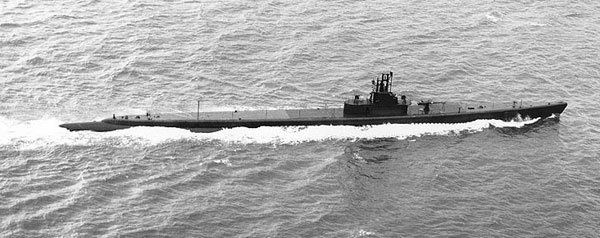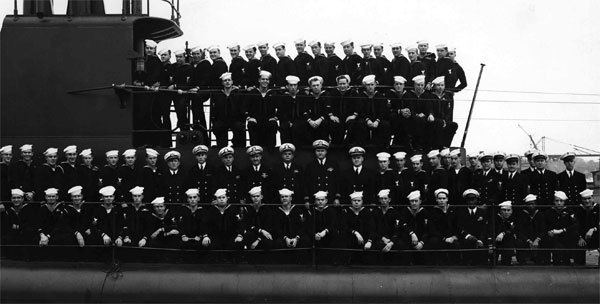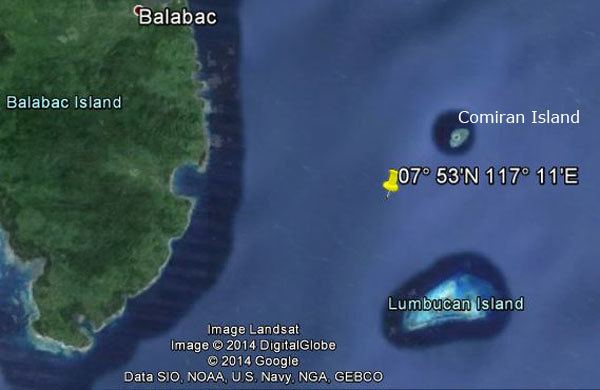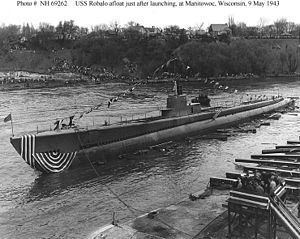Name Robalo Commissioned 28 September 1943 Construction started 24 October 1942 Length 95 m | Laid down 24 October 1942 Struck 16 September 1944 Launched 9 May 1943 | |
 | ||
Fate Mined west of Palawan, 26 July 1944. 4 of the 81 crew survived, died as POW's Builder | ||
USS Robalo (SS-273), a Gato-class submarine, was the only ship of the United States Navy to be named for the róbalo or common snook. Her keel was laid down on 24 October 1942 by the Manitowoc Shipbuilding Company at Manitowoc, Wisconsin. She was launched on 9 May 1943, sponsored by Mrs. E.S. Root, and commissioned on 28 September 1943.
Contents
First patrol

After passage by inland waterways and being floated down the Mississippi River, Robalo deployed to the Pacific. On her first war patrol (under the leadership of Commander Stephen Ambruster, Annapolis Class of 1928), she sortied from Pearl Harbor, hunting Japanese ships west of the Philippines. On 12 February 1944 Armbruster reported seeing a large 2 masted sailboat. There, en route to her new station in Fremantle submarine base, Western Australia, she had an encounter with enemy vessels: on 13 February 1944 east of the Verde Island Passage the Rabalo had come across a convoy of two large ships escorted by a minesweeper which dropped 13 depth charges and fired twice at the submarine with a deck gun; although USS Robalo is "credited" with damaging a large freighter, firing four torpedoes at 3,100 yards (2,800 m) in fact the attack was unsuccessful and no enemy vessels were damaged or sunk. She spent 36 of her 57-day mission submerged. When she arrived, her commanding officer was summarily relieved by Admiral Christie and replaced with Manning Kimmel (Class of 1935).

In March 1944, Christie (based on Ultra) feared surprise from a strong Japanese force. When Chester W. Nimitz, Jr. in USS Haddo (SS-255), made contact on his SJ radar and reported "many large ships", Christie scrambled to respond. Robalo, along with USS Flasher (SS-249), USS Hoe (SS-258), USS Hake (SS-256), and USS Redfin (SS-272) all ran to intercept. No attack ever materialized.
Second patrol

For her second patrol, Robalo went to the South China Sea, assigned to interdict Japanese tanker traffic from French Indochina to the fleet anchorage at Tawi Tawi. On 24 April 1944 off Indochina she was bombed by a Japanese antisubmarine aircraft, suffering shattered and flooded periscopes and loss of radar, while taking a harrowing plunge to 350 feet (110 m) after her main induction was improperly closed (a casualty frighteningly reminiscent of Squalus) in diving to escape. {The "Robalo" had been seen by Japanese aircraft carrier Kaiyō while escorting convoy Hi-58; which resulted in the "Robalo" being damaged 24 April 1944 one of the ships which escaped damage from the "Robalo" was the Mayasan Maru.} On a "wildly aggressive patrol" lasting 51 days, Robalo fired twenty torpedoes in four attacks. In regard to the four claims by the Robalo: on May 3, 1944 6 torpedoes against a 4000-ton freighter {no damage}; May 8, 1944 4 torpedoes against a 1900-ton submarine {no damage}; May 17, 1944 6 torpedoes against a 7500 tanker {1 hit} and 4 torpedoes against a 1500-ton destroyer {no damage}. She was credited with sinking a 7500-ton tanker which was not confirmed postwar by JANAC. When she returned to Fremantle, Captain "Tex" McLean (commanding Subron 16) and Admiral Christie both considered relieving Robalo's skipper for his own safety.
Third patrol
Robalo departed Fremantle on 22 June 1944 on her third war patrol. She set a course for the South China Sea to conduct her patrol in the vicinity of the Natuna Islands. After transiting Makassar Strait and Balabac Strait (which was well-known to be mined), she was scheduled to arrive on station about 6 July and remain until dark on 2 August 1944. On 2 July, a contact report stated Robalo had sighted a Fusō-class battleship, with air cover and two destroyers for escort, just east of Borneo. No other messages were ever received from the submarine and when she did not return from patrol, she was presumed lost.
Fate of survivors
On 2 August, a note was dropped from the window of a cell of Puerto Princesa Prison Camp on Palawan Island in the Philippines. It was picked up by an American soldier who was on a work detail nearby. The note was in turn given to H.D. Hough, Yeoman Second Class, who was also a prisoner at the camp. On 4 August, he contacted Trinidad Mendosa, wife of guerrilla leader Dr. Mendosa who furnished further information on the survivors.
From these sources, it was concluded Robalo was sunk on 26 July 1944, 2 miles (3.2 km) off the western coast of Palawan Island from an explosion in the vicinity of her after battery, probably caused by an enemy mine. Only four men swam ashore, and made their way through the jungles to a small barrier northwest of the Puerto Princesa Prison Camp, where Japanese Military Police captured them and jailed them for guerrilla activities. On 15 August, they were evacuated by a Japanese destroyer and never heard from again. The exact fate of the 4 survivors is unknown
Even though Admiral Christie knew better it was reported for morale reasons that all hands went down with the boat. However, other prisoners on Palawan reported that the boat's skipper Lt. Cdr. Manning Kimmel, son of Admiral Husband Kimmel, was one of the survivors. After an air strike on Palawan the Japanese were so angered that they pushed Kimmel and other prisoners into a ditch poured in gasoline and burned them alive. This incident was reported by Clay Blair Jr., himself a veteran of the submarine war, and author of the definitive work Silent Victory. See Volume 2, pp660–662 for details.
Robalo was stricken from the Naval Vessel Register on 16 September 1944.
Robalo earned two battle stars for World War II service.
